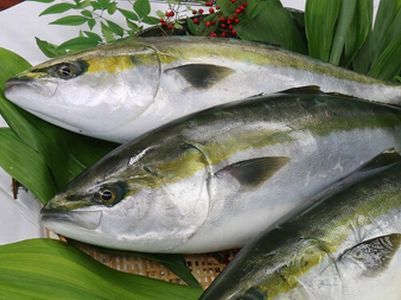 In the United States and other countries, “Buri: right image” is called yellowtail, but this word refers to fish like “buri” and “hiramasa” and actually can be applied to a large number of fish. Actually, it isn’t far off since a layman can’t tell the difference between a “buri” and “hiramasa” just by the pretty yellow line on the side of the fish’s body.
In the United States and other countries, “Buri: right image” is called yellowtail, but this word refers to fish like “buri” and “hiramasa” and actually can be applied to a large number of fish. Actually, it isn’t far off since a layman can’t tell the difference between a “buri” and “hiramasa” just by the pretty yellow line on the side of the fish’s body.
In Japan, “buri” is the most well-known fish that goes by different names depending on its stage in life (shusse fish). Actually “buri” has many different names even depending on the region you are in. For example, in the Kanto region, it may be called wakashi (0 to 30 cm) → Inada (30 to 60 cm) → Warasa (60 to 80 cm) → Buri (80 cm or more), and from Kansai on further west, it is called, Tsubasu (0 to 30 cm) → Hamachi (30 to 60 cm)→ Mejiro (60 to 80 cm) or Buri (80 cm or more).
This is where the term “hamachi” came from West of Kansai, full-grown buri, at about 30 to 60 cm is called Hamachi. In other words, Hamachi is a young buri.
Of course, it’s not that simple. You can get hamachi sashimi at grocery stores all over Japan, all year long. Hamachi is not only used from Kansai westward, it is also used at grocery stores throughout Japan. This may lead you to believe that hamachi is a different fish and not the same as buri, but you would be mistaken.
Behind the curtain, buri cultivation is thriving in Japan (and throughout the world). More than 80% of the buri on the market is said to be farmed. Because it is not apparent by appearance whether the buri was raised in the wild or by aquaculture, the wild-raised fish is called buri by market affiliates in order to make it easier to understand. That means farmed products have come to be called hamachi.
Also, in the Setouchi region, people preferred to eat the young hamachi rather than the adult buri. Kagawa Prefecture became the first in the world to successfully cultivate hamachi in 1928, and that is what led ‘hamachi’ to become synonymous with ‘farmed fish’. Of course, that would be one reason that people call farmed buri, hamachi.
What is the difference in taste between wild buri and farmed hamachi?
Buri (yellowtail) is a fish for which the name changes according to the stage of growth. We would like to start this article by reviewing the definition of “hamachi”.
Jumping right into it, medium-sized (30-60 cm), farmed “inada” or “wakashi” class buri is called “hamachi”. Even in Kanto, the names inada and wakashi are only used for wild fish, while hamachi is used for farmed fish.
The accepted theory is that the delicious flavor of Kanburi (wild buri caught during the cold months of November to February that has grown fat for the winter) depends heavily on the condition of high-fat content. The two major brands of Kanburi are caught on the Noto Peninsula and Himi in the Hokuriku region, and buri caught in Hokuriku has a higher fat content and also tastes better than buri caught in other places. This may be because fish that live in the frigid sea have higher fat content than those that live in warm seawaters.
You don’t know the true taste of buri until you’ve had Kanburi. It is especially popular as sashimi. The fat of the buri enters the muscle tissue, turning the fat into an incredible texture that practically melts in your mouth. Whether farmed or wild, the lipid content reaches its peak from December to January. This is 10% lipid content in the wild fish, but 25 to 30% in the farmed version.
The peak season of the medium-sized class of buri is summer, and the fat content for that season is 5 to 7% in inada and wakashi. and around 8 to 15% in hamachi. While the fat content in farmed buri is overwhelmingly higher than in wild buri, unfortunately, this does not translate to better taste. Throughout the world, buri with soft meat that has fat that glistens above the meat like hamachi sashimi, is popular, but after years of eating it, the wild buri always ends up tasting better.
Winter is the season for wild buri. The lipid content during winter is only around 10%, but this makes both the taste and the aftertaste better. The reason that the lipid content of farmed buri is higher than wild buri, is that sardine fish meal and farmed fish feed oil are used in the formula feed, or sardines, which are high in fat content, are fed as-is to the buri. However, in recent years there has been researched in formula feed for hamachi and buri with higher meat quality, which has improved the results.
When comparing flavor, wild buri has a higher content of umami, such as inosinic acid, in the meat than farmed buri. It is especially high in nitrogenous extractives, histidine, trimethylamine oxide, etc., which makes the flavor richer. In contrast, the meat of farmed buri is soft without much umami. This is probably one of the reasons that it feels greasy.
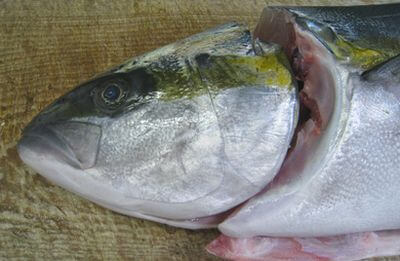 As an aside, three cousins (closely related species) of buri are often used as sushi toppings in sushi restaurants. In the Fish Name Dictionary, the translations of these cousins are Goldstriped amberjack (Hiramasa: right image), Greater Amberjack (Kanpachi), and Japanese amberjack (Buri). Sushi University also adopts these terms.
As an aside, three cousins (closely related species) of buri are often used as sushi toppings in sushi restaurants. In the Fish Name Dictionary, the translations of these cousins are Goldstriped amberjack (Hiramasa: right image), Greater Amberjack (Kanpachi), and Japanese amberjack (Buri). Sushi University also adopts these terms.
But if you dive deeper into the fish name dictionary,
Hiramasa is known as amberjack or yellowtail or hiramasa kingfish. Kampachi is known as amberjack or yellowtail. Buri is known as… you guessed it: amberjack or yellowtail.
When lumping them all together, they are called yellowtail, as is common in the U.S.
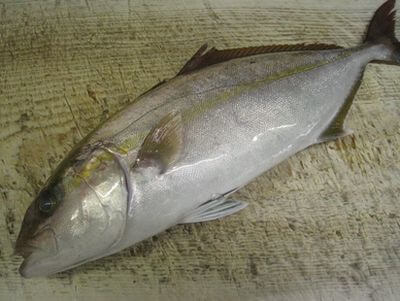 I’m sure you’re interested in the price, and while the price of the seasonal winter buri varies, it is generally around $10-20 per kilogram. Since there is very little distribution of hiramasa, the price is said to be about double that of buri. The price of Kampachi: right image is somewhere between that of buri and hiramasa. These prices refer to the wild-caught fish.
I’m sure you’re interested in the price, and while the price of the seasonal winter buri varies, it is generally around $10-20 per kilogram. Since there is very little distribution of hiramasa, the price is said to be about double that of buri. The price of Kampachi: right image is somewhere between that of buri and hiramasa. These prices refer to the wild-caught fish.
Finally, if you eat and compare buri, kampachi and hiramasa in sashimi form, most people can’t tell the difference in fat distribution. When made into sushi (buri sushi, hamachi sushi, hiramasa sushi, kampachi sushi), the sweetness of the fat and the flavor of the fish emerge splendidly, and the taste of each fish becomes distinct and obvious. Even the still-developing inada, with very low-fat content, is used as a sushi topping and its refreshing taste is unforgettable. This showcases both the depth and greatness of Edomae (Edo Style) sushi.
Related contents:
The answer to the question, “Can I eat sushi leftovers the next day?”
We hope this information will be helpful.

Revision date: April 1, 2022
Share this article
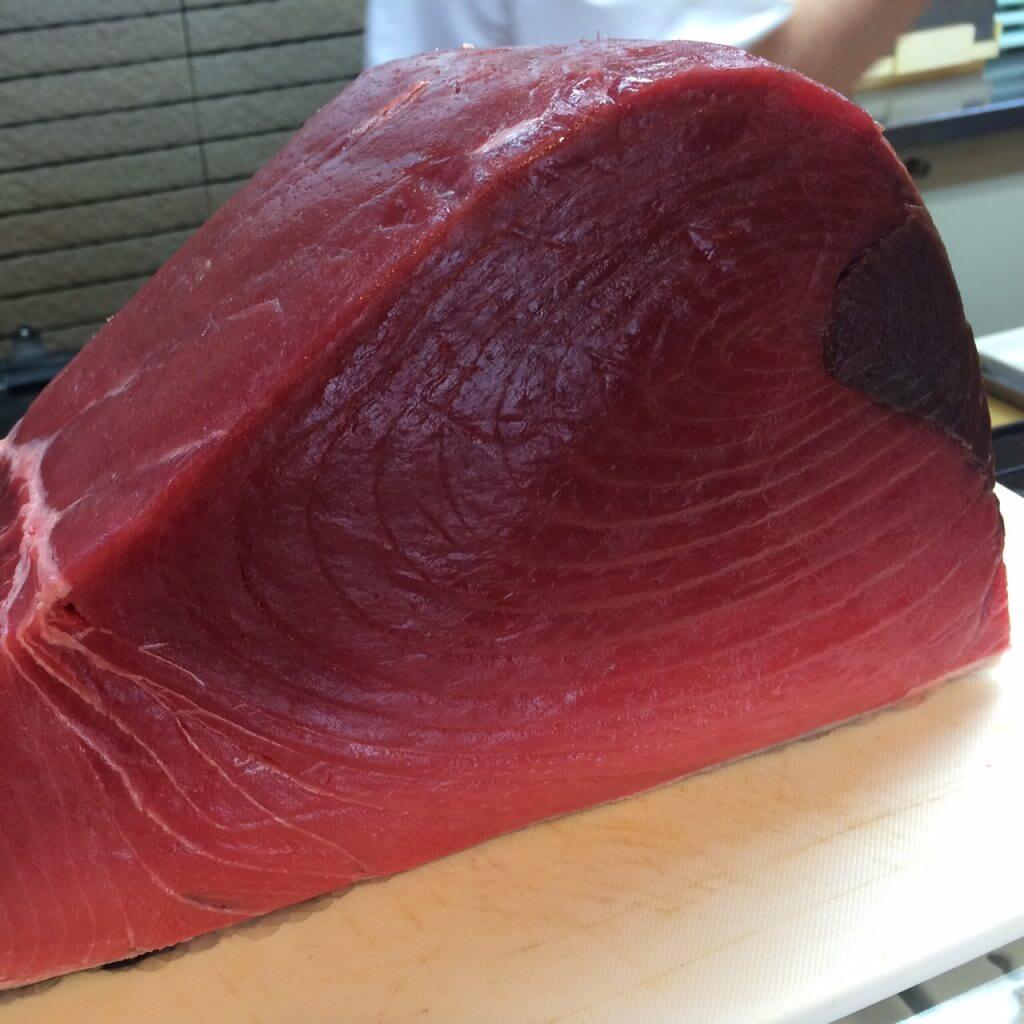 Why is only tuna brought into certain ports high-priced, even though all of the tuna is caught in the seas near Japan? This is because the level of stress caused to the fish when it is caught has a huge impact on the quality, including taste, color and texture. In other words, the same fish may be delicious or taste unpleasant depending on how the fisher handles the fish directly after catching it. Naturally, everyone ends up wanting the fish from the ports with fisherman who are skilled in this practice*. Furthermore, it is individuals who process the fish. The quality changes drastically depending on who caught it.
Why is only tuna brought into certain ports high-priced, even though all of the tuna is caught in the seas near Japan? This is because the level of stress caused to the fish when it is caught has a huge impact on the quality, including taste, color and texture. In other words, the same fish may be delicious or taste unpleasant depending on how the fisher handles the fish directly after catching it. Naturally, everyone ends up wanting the fish from the ports with fisherman who are skilled in this practice*. Furthermore, it is individuals who process the fish. The quality changes drastically depending on who caught it.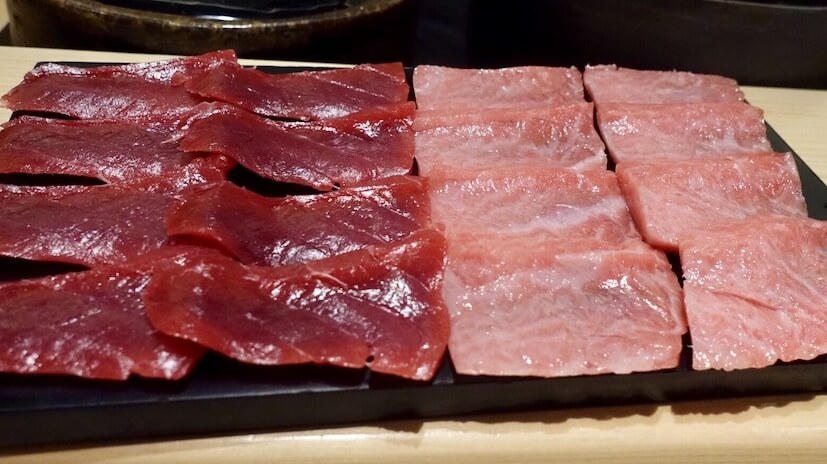 However, sushi chefs will remove the topping from the refrigerator and leave it standing out for a while (in the case of tuna, the fat will melt at around 23℃). They do this because if the topping is cold, it becomes difficult to taste the essential nature of the fish. The temperature of the shari is best at human skin temperature (around 36℃) to maximize the taste and sweetness of the rice. However, the ideal temperature differs very slightly depending on the topping.
However, sushi chefs will remove the topping from the refrigerator and leave it standing out for a while (in the case of tuna, the fat will melt at around 23℃). They do this because if the topping is cold, it becomes difficult to taste the essential nature of the fish. The temperature of the shari is best at human skin temperature (around 36℃) to maximize the taste and sweetness of the rice. However, the ideal temperature differs very slightly depending on the topping.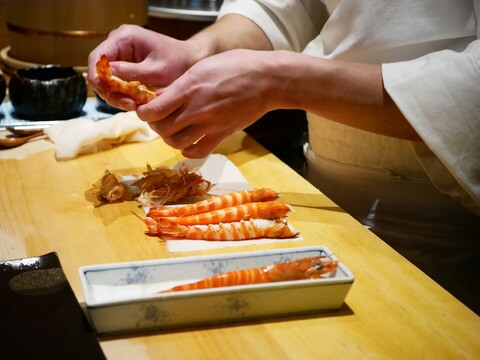 For example, conger eel which is often lightly grilled or prepared in another, similar way, should have a slightly higher temperature (around 42℃) than the shari, and kuruma prawn, which are boiled, should be the same temperature as the shari.
For example, conger eel which is often lightly grilled or prepared in another, similar way, should have a slightly higher temperature (around 42℃) than the shari, and kuruma prawn, which are boiled, should be the same temperature as the shari.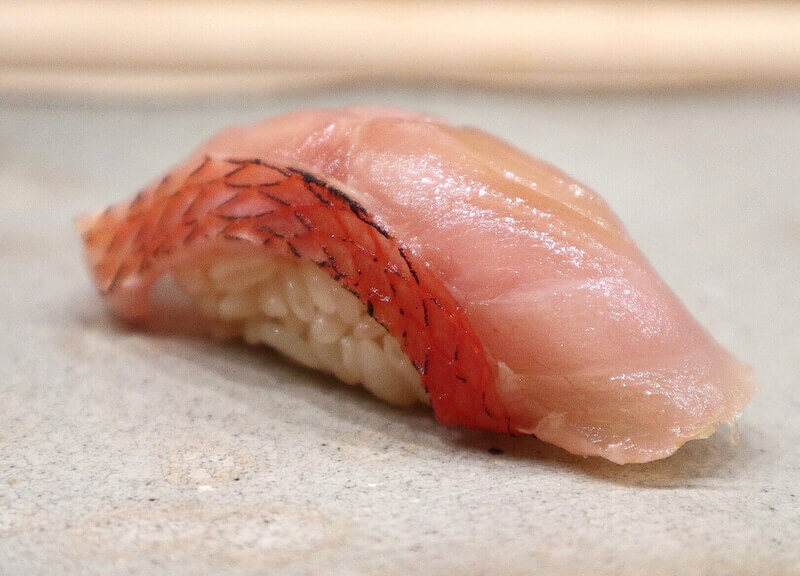 No one is more sensitive to the changing of the seasons than sushi lovers. This must be because the taste of sushi toppings is directly tied to the seasons. There are terms to describe this such as Hashiri (early season), Sakari (in-season) and Nagori (late season), and using these words to understand what state the sushi topping is it allows you to grasp and enjoy the various different flavors. There is nothing that says a sushi topping is less delicious because it has a lower fat content.
No one is more sensitive to the changing of the seasons than sushi lovers. This must be because the taste of sushi toppings is directly tied to the seasons. There are terms to describe this such as Hashiri (early season), Sakari (in-season) and Nagori (late season), and using these words to understand what state the sushi topping is it allows you to grasp and enjoy the various different flavors. There is nothing that says a sushi topping is less delicious because it has a lower fat content.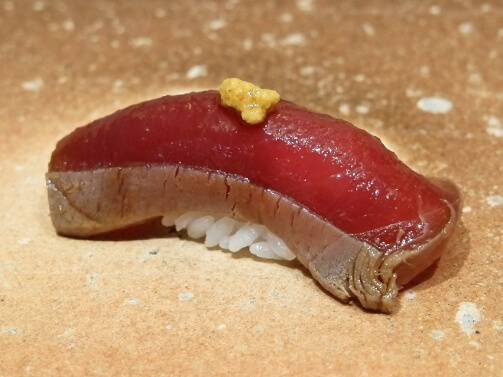 Japanese mustard refers to
Japanese mustard refers to 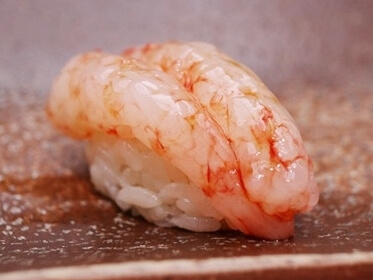 Fish seasons are categorized as the ‘catch season’ and the ‘flavor season’. The ‘catch season’ is the time when lots of fish can be caught and are cheap. Take Japanese Spanish mackerel (Sawara), for example, they approach the coasts during the spring to spawn and this is the peak season. This is the catch season. Once they’re about to spawn and their bodies fatten for winter, we’ve entered the tasting season. However, these seasons differ depending on the region, and may be longer or even happen twice a year.
Fish seasons are categorized as the ‘catch season’ and the ‘flavor season’. The ‘catch season’ is the time when lots of fish can be caught and are cheap. Take Japanese Spanish mackerel (Sawara), for example, they approach the coasts during the spring to spawn and this is the peak season. This is the catch season. Once they’re about to spawn and their bodies fatten for winter, we’ve entered the tasting season. However, these seasons differ depending on the region, and may be longer or even happen twice a year.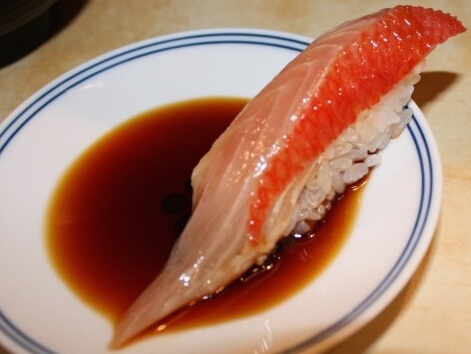 There is a sensor on the tongue that feels the degree of saltiness. This prevents us from eating too much of things that are extremely salty. Chemical seasonings confuse that sensor. The chemical seasoning palliates the degree of saltiness felt by the tongue. Even if you were to, for example, dunk your sushi into the soy sauce and chemical seasoning mixture, it won’t feel salty. If you eat sushi with the sauce, you can take in a high volume of sodium, which is a pleasure trigger for the human body, without feeling the saltiness on your tongue. In other words, it may be more accurate to say that with commoner sushi, you actually drink the sauce, not dip into it.
There is a sensor on the tongue that feels the degree of saltiness. This prevents us from eating too much of things that are extremely salty. Chemical seasonings confuse that sensor. The chemical seasoning palliates the degree of saltiness felt by the tongue. Even if you were to, for example, dunk your sushi into the soy sauce and chemical seasoning mixture, it won’t feel salty. If you eat sushi with the sauce, you can take in a high volume of sodium, which is a pleasure trigger for the human body, without feeling the saltiness on your tongue. In other words, it may be more accurate to say that with commoner sushi, you actually drink the sauce, not dip into it.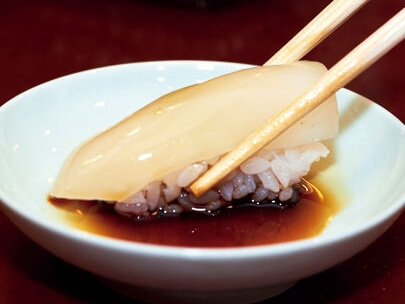 The difference between common people who eat this sauce and foodies is a delicate nose, meaning their sense of smell. This sense is acquired through childhood experiences and repetition after becoming an adult. Tasting through sense of smell is a person’s food culture. The reason that the so-called celebrities, or the upper class made through business success, don’t have an appreciation for high-class sushi restaurants is because they don’t have this culture of distinguishing by smell, or the culture of feeling the seasons. Also, in order to target the upper-middle class clientele, it is important to use strong flavors and give a performance that is easy to understand, while worrying about details is not necessary. That is why the obvious show of using a burner for searing is popular.
The difference between common people who eat this sauce and foodies is a delicate nose, meaning their sense of smell. This sense is acquired through childhood experiences and repetition after becoming an adult. Tasting through sense of smell is a person’s food culture. The reason that the so-called celebrities, or the upper class made through business success, don’t have an appreciation for high-class sushi restaurants is because they don’t have this culture of distinguishing by smell, or the culture of feeling the seasons. Also, in order to target the upper-middle class clientele, it is important to use strong flavors and give a performance that is easy to understand, while worrying about details is not necessary. That is why the obvious show of using a burner for searing is popular.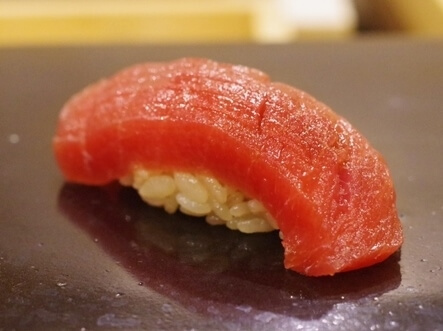 Natural fish are part of the food chain and have concentrations of harmful substances. Since 2000 the amount of mercury found in fish has become an issue. The American Natural Resources Defense Council has said tuna is a fish that should be avoided if pregnant or planning to get pregnant. A more recent problem is the large amounts of micro plastics found in fish meat. This shocking phenomenon will likely be reported by research organizations at some point in time. If it does reach that extreme, then it will be better to avoid the danger of eating fish.
Natural fish are part of the food chain and have concentrations of harmful substances. Since 2000 the amount of mercury found in fish has become an issue. The American Natural Resources Defense Council has said tuna is a fish that should be avoided if pregnant or planning to get pregnant. A more recent problem is the large amounts of micro plastics found in fish meat. This shocking phenomenon will likely be reported by research organizations at some point in time. If it does reach that extreme, then it will be better to avoid the danger of eating fish.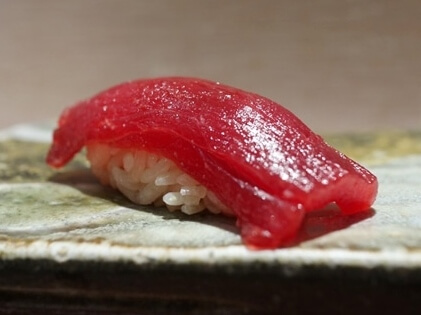 Tuna at top-end restaurants is light in flavor. Its Akami (red meat) has an indescribable acidity with a delicate harmony between the shari vinegar, the nikiri soy sauce, and wasabi. However, on the other side of the coin, it feels almost like a waste to eat it without a sense of luxury. Of course tuna with delicious akami, also has delicious fatty tuna (toro). And you’ll never get tired of it. It would be easy to polish off 10 pieces as a light snack. Contrary to popular belief, it’s not the high fat content that makes it so easy to eat. However, it is because of that popular belief that many people feel that the big chain store
Tuna at top-end restaurants is light in flavor. Its Akami (red meat) has an indescribable acidity with a delicate harmony between the shari vinegar, the nikiri soy sauce, and wasabi. However, on the other side of the coin, it feels almost like a waste to eat it without a sense of luxury. Of course tuna with delicious akami, also has delicious fatty tuna (toro). And you’ll never get tired of it. It would be easy to polish off 10 pieces as a light snack. Contrary to popular belief, it’s not the high fat content that makes it so easy to eat. However, it is because of that popular belief that many people feel that the big chain store 
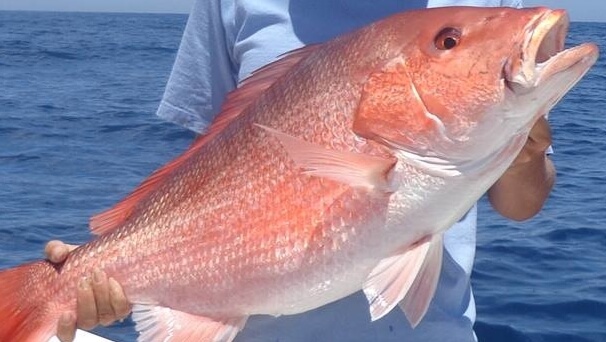 Biologically, Snapper is a generic term for all species in the snapper family (
Biologically, Snapper is a generic term for all species in the snapper family (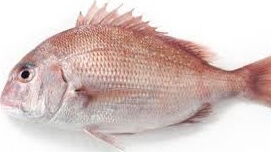 They say there are over 300 different species of fish with “Tai” in the name, making up 10% of Japan’s fish. When we say “Tai” in Japanese, we are referring to “madai” or red sea bream. Red sea-bream is categorized in the “madai” family (
They say there are over 300 different species of fish with “Tai” in the name, making up 10% of Japan’s fish. When we say “Tai” in Japanese, we are referring to “madai” or red sea bream. Red sea-bream is categorized in the “madai” family (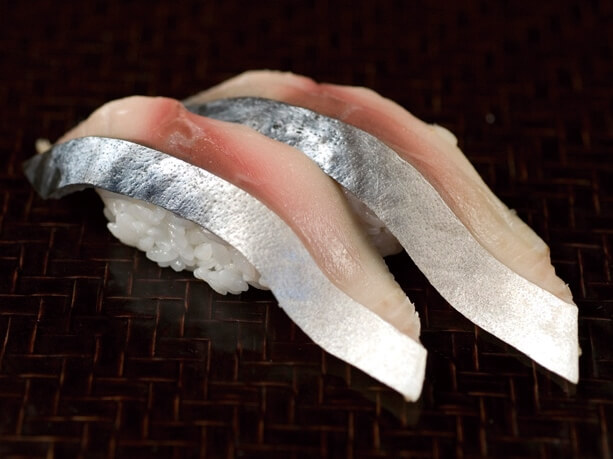 When you sit at the counter and order nigiri a la carte, they will come out in pairs.* There is nothing wrong with counting these in the regular Japanese way “ikko,” “niko.”
When you sit at the counter and order nigiri a la carte, they will come out in pairs.* There is nothing wrong with counting these in the regular Japanese way “ikko,” “niko.”